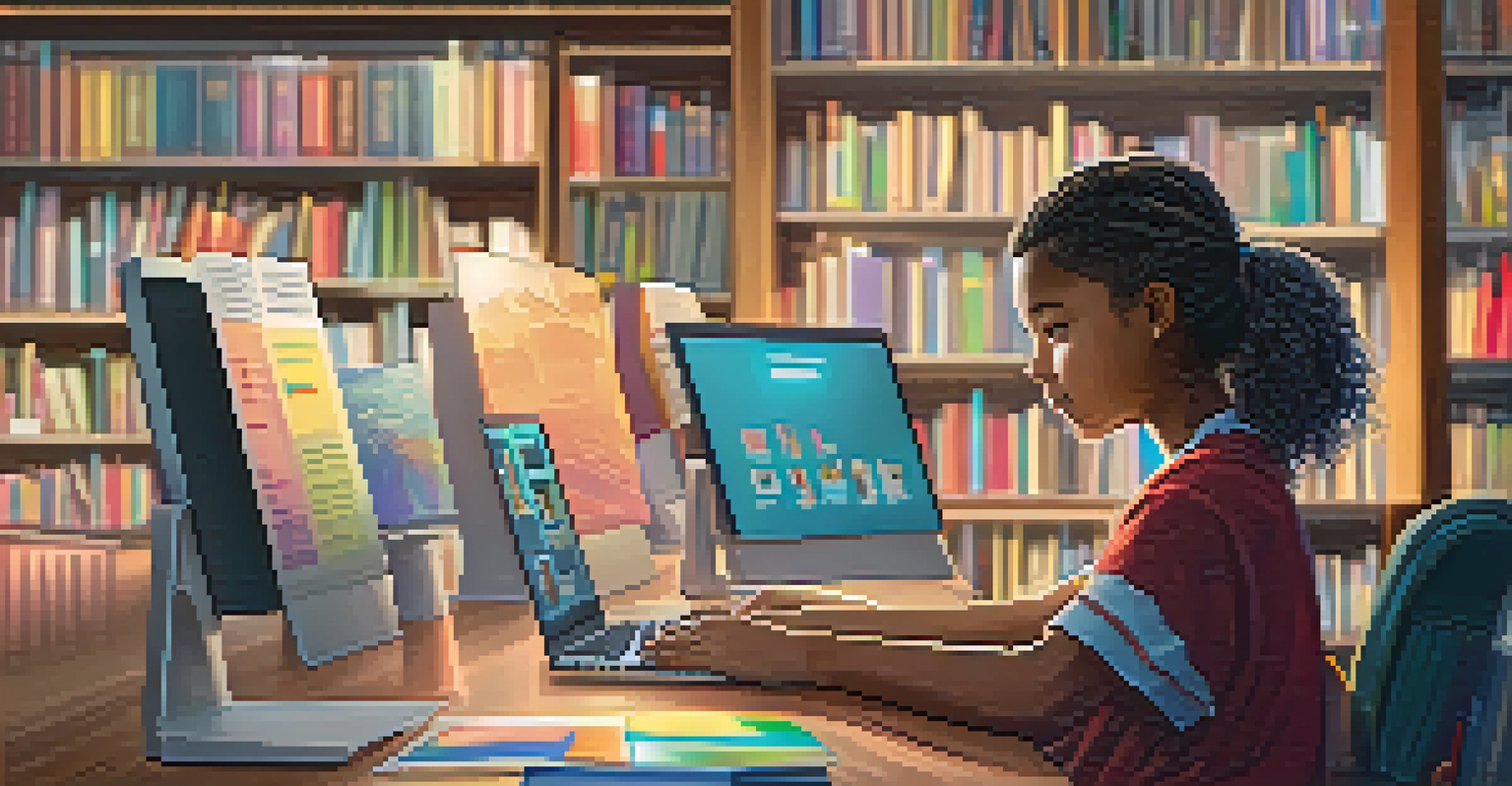Public Libraries: Bridging Gaps in Educational Resources

The Role of Public Libraries in Education
Public libraries serve as vital educational hubs for communities, providing access to diverse resources. They offer everything from books to online courses, ensuring that everyone can find materials that suit their learning needs. By making education accessible, libraries help bridge the gap for those who may not have resources at home.
A library is not a luxury but one of the necessities of life.
In many cases, public libraries are the first point of contact for lifelong learners. They host workshops, tutoring sessions, and literacy programs that cater to various age groups. This makes them essential in fostering a culture of learning and curiosity within the community.
Moreover, libraries often collaborate with local schools and organizations to enhance educational outreach. These partnerships help amplify their impact, ensuring that educational resources are not only available but also effectively utilized by those who need them most.
Access to Technology and Digital Resources
In today’s digital age, access to technology is crucial for education. Public libraries provide free access to computers, high-speed internet, and various software programs. This is particularly important for individuals who may lack these resources at home, as it levels the playing field for all learners.

Through digital literacy programs, libraries teach patrons how to use technology effectively. From basic computer skills to advanced research techniques, these programs empower individuals to navigate the digital landscape confidently. This is especially significant for job seekers and students who rely on technology for their educational pursuits.
Libraries as Educational Hubs
Public libraries provide diverse resources and programs that make education accessible to all community members.
Additionally, many libraries offer online databases and e-learning platforms that patrons can access from home. This means that education is no longer confined to the library’s physical space; learning can happen anytime, anywhere, making it even more accessible.
Diverse Learning Opportunities for All Ages
Public libraries cater to a wide age range, offering programs for children, teens, and adults. Storytime sessions for young children ignite a love for reading early on, while summer reading programs keep students engaged when school is out. These initiatives are designed to foster a lifelong love of learning.
The only thing that you absolutely have to know, is the location of the library.
For teens, libraries often host book clubs, coding workshops, and college prep sessions. These programs not only provide educational resources but also create a supportive community where young people can explore their interests. It’s a safe space for them to grow and learn beyond the classroom.
Adults also benefit from a variety of offerings, including career development workshops, language classes, and health seminars. This diverse range of programs ensures that education remains a priority throughout one’s life, promoting personal and professional growth.
Promoting Literacy and Lifelong Learning
Literacy is the cornerstone of education, and public libraries play a pivotal role in promoting it. They provide resources and programs aimed at improving reading and writing skills for individuals of all ages. This is particularly important in communities where literacy rates may be lower, as it helps uplift the entire population.
In addition to traditional reading materials, libraries offer access to audiobooks, e-books, and interactive learning tools. This variety caters to different learning styles, making literacy more engaging and accessible. By meeting patrons where they are, libraries foster an environment where everyone can thrive.
Technology Access for Learning
By offering free technology and digital literacy programs, public libraries help level the playing field for learners without home resources.
By encouraging lifelong learning, libraries help individuals continuously develop their skills. Whether it’s through adult education classes or access to online resources, the commitment to learning doesn’t stop after formal education. Libraries inspire people to keep seeking knowledge throughout their lives.
Community Engagement and Support
Public libraries are more than just places to borrow books; they are community gathering spots. They host events and programs that bring people together, fostering a sense of belonging. This communal aspect is crucial in building strong, supportive networks that encourage learning.
Through partnerships with local organizations, libraries often provide resources for underserved populations. This could include hosting job fairs, health screenings, or cultural events that enrich the community. By addressing these needs, libraries actively contribute to the overall well-being of their neighborhoods.
Moreover, libraries encourage volunteers and community members to participate in programming. This involvement not only strengthens community ties but also empowers individuals to take an active role in fostering education and resources for others.
Challenges Faced by Public Libraries
Despite their importance, public libraries face several challenges in delivering educational resources. Budget cuts and reduced funding can limit the range of programs and services offered. This often leads to a reliance on community support and donations to fill the gaps.
Additionally, the rapid pace of technological change can be daunting for libraries. Keeping up with the latest tools and digital resources requires continuous training and investment. Libraries must find ways to adapt to these changes to remain relevant in an increasingly digital world.
Lifelong Learning and Community
Public libraries foster lifelong learning through varied programs for all ages, while also serving as community gathering spots that enhance engagement.
Moreover, some communities may experience barriers to accessing library services, such as transportation issues or lack of awareness. Addressing these challenges is essential to ensure that every individual can benefit from the educational resources libraries provide.
The Future of Public Libraries in Education
Looking ahead, public libraries are poised to play an even more significant role in education. As technology continues to evolve, libraries can leverage these advancements to enhance their offerings. This could mean more virtual programs, digital resources, and partnerships with educational institutions.
Additionally, there is a growing recognition of the importance of social-emotional learning. Libraries are likely to expand their focus on programs that support mental health and well-being, providing safe spaces for individuals to connect and grow. This holistic approach to education will benefit learners of all ages.

Ultimately, the future of public libraries lies in their ability to adapt and innovate. By remaining responsive to community needs and embracing new technologies, libraries will continue to be essential in bridging gaps in educational resources for generations to come.